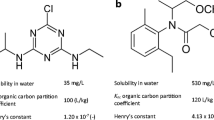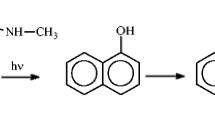Abstract
In today’s agriculture, the use of pesticides has become a necessity for higher yield of crops. Out of the total pesticides applied, only a small fraction reaches the target pest and the rest pollute different environmental segments. The present study signifies the effect of soil moisture and enhanced sunlight intensity on the degradation of dimethoate, a commonly used organophosphate pesticide in soil. The study was conducted in dry, field capacity, and submerged soils under enhanced sunlight conditions (3 intensity levels) obtained by using a solar collector. Higher degradation was observed in submerged soil followed by dry and field capacity soils under all the light conditions and might have occurred through radical mediated mechanism. When sunlight intensity was almost doubled, the pesticide residue was 17.2% less but 9% higher as compared to UV light in submerged soil after 30 days of experimentation, mainly due to the increase in UV component of enhanced sunlight intensity. Therefore, although artificial UV light is still most effective in pesticide degradation, enhanced sunlight can also play an important role and be used as a viable, economical, and greener technique. Statistically, sunlight intensity and the degradation rate were correlated positively. Moreover, the degradation of the pesticide in soil followed first order kinetic model. The half-life of the pesticide varied widely from 7.96 to 41.11 days under different soil moisture and sunlight conditions. This study can help in understanding and modeling the degradation behavior of dimethoate under varying soil and environmental conditions.







Similar content being viewed by others
Data Availability
The data used during the current study are available from the corresponding author on reasonable request.
References
Bustos, N., Alcalde, A. C., Iriel, A., Cirelli, A. F., & Sans, C. (2019). Sunlight and UVC-254 irradiation induced photodegradation of organophosphorus pesticide dichlorvos in aqueous matrices. Science of the Total Environment, 649, 592–600.
Bhushan, C., Bhardwaj, A., & Misra, S.S. (2013). State of pesticide regulations in India. Centre for Science and Environment, New Delhi.
Chatterjee, N. S., Gupta, S., & Varghese, E. (2013). Degradation of metaflumizone in soil: Impact of varying moisture, light, temperature, atmospheric CO2 level, soil type and soil sterilization. Chemosphere, 90(2), 729–736.
Choudhury, B. K., & Awasthi, M. D. (2000). Persistence and degradation of chlorothalonil under different moisture regimes. Pesticide Research Journal, 12(2), 170–173.
Díaz-López, M., García, C., Garrido, I., Navarro, S., Vela, N., Nicolás, E., Fenoll, J., & Bastida, F. (2019). Solarization-based pesticide degradation results in decreased activity and biomass of the soil microbial community. Geoderma, 354, 1–6. https://doi.org/10.1016/j.geoderma.2019.113893
Durovic, R., Jelena, G. U., & Dordevic, T. (2009). Effects of organic matter and clay content in soil on pesticide adsorption processes. Journal of Pesticides and Phytomedicine, 24, 51–57.
Fang, G., Lau, H. F., Law, W. S., & Li, S. F. Y. (2012). Systematic optimisation of coupled microwave-assisted extraction-solid phase extraction for the determination of pesticides in infant milk formula via LC–MS/MS. Food Chemistry, 134(4), 2473–2480.
Frank, M. P., Graebing, P., & Chib, J. S. (2002). Effect of soil moisture and sample depth on pesticide photolysis. Journal of Agricultural and Food Chemistry, 50(9), 2607–2614.
Ganier, C. P., Breuzin, C., Portal, J. M., & Schiavon, M. (1996). Availability and persistence of isoproturon under field and laboratory conditions. Ecotoxicology and Environmental Safety, 35(3), 226–230.
Gavrilescu, M. (2005). Fate of pesticides in the environment and its bioremediation. Engineering in Life Sciences, 5(6), 497–526.
Ghosh, R. K., & Singh, N. (2009). Sorption and degradation of azoxystrobin in soil. Journal of Agricultural and Food Chemistry, 57(2), 632–636.
Gupta, S., Gajbhiya, V. T., & Gupta, R. K. (2008). Effect of light on the degradation of two neonicotinoids viz acetamiprid and thiacloprid in soil. Bulletin of Environmental Contamination and Toxicology, 81(2), 185–189.
Gupta, S., & Gajbhiye, V. T. (2002). Persistence and leaching of b-cyfluthrin in alluvial soil of India. Pest Management Science, 58(12), 1259–1265.
Higarashi, M. M., & Jardim, W. F. (2002). Remediation of pesticide contaminated soil using TiO2 mediated by solar light. Catalysis Today, 76(2), 201–207.
Hill, C. G. (1977). An introduction to chemical engineering kinetics and reactor design. Wiley.
Konstantinou, I. K., Zarkadis, A. K., & Albanis, T. A. (2001). Photodegradation of selected herbicides in various natural waters and soils under environmental conditions. Journal of Environmental Quality, 30(1), 121–130.
Miller, G. C., & Zepp, R. G. (1983). Extrapolating photolysis rates from the laboratory to the environment. Residue Reviews, 85, 89–110.
Momani, F. A. A., Shawaqfeh, A. T., & Shawaqfeh, M. S. (2007). Solar wastewater treatment plant for aqueous solution of pesticide. Solar Energy, 81(10), 1213–1218.
Muller, P. (1994). Glossary of terms used in physical organic chemistry (IUPAC recommendation 1994). Pure and Applied Chemistry, 66(5), 1077–1184.
Oyama, T., Otsu, T., Hidano, Y., Koike, T., Serpone, N., & Hidaka, H. (2011). Enhanced remediation of simulated wastewaters contaminated with 2-chlorophenol and other aquatic pollutants by TiO2-photoassisted ozonation in a sunlight-driven pilot-plant scale photoreactor. Solar Energy, 85(5), 938–944.
Rani, S., & Sud, D. (2014). Time and temperature dependent sorption behaviour of dimethoate pesticide in various Indian soils. International Agrophysics, 28(4), 479–490.
Rani, S., & Sud, D. (2015). Role of enhanced solar radiation for degradation of triazophos pesticide in soil matrix. Solar Energy, 120(10), 494–504.
Rani, S., & Sud, D. (2017). Kinetic study on triazophos adsorption in soil and its persistence behaviour in different environmental segments. Agrochimica, 61(3), 206–220.
Senthilnathan, J., & Philip, L. (2012). Elimination of pesticides and their formulation products from drinking water using thin film continuous photoreactor under solar radiation. Solar Energy, 86(9), 2735–2745.
Shahgholi, H., & Ahangar, A. G. (2014). Factors controlling degradation of pesticides in the soil environment: A review. Agricultural Science Developments, 3(8), 273–278.
Siampiringue, M., Chung, P. W. W., Koriko, M., Tchangbedji, G., & Sarakha, M. (2014). Clay and soil photolysis of the pesticides mesotrione and metsulfuron methyl. Applied and Environmental Soil Science, 2014, 1–8.
Smith, J. M. (1970). Chemical engineering kinetics. McGraw-Hill.
Wolfe, N. L., Mingelgrin, U., & Miller, C. G. (1990). Abiotic transformations in water, sediments and soil. In H. H. Cheng (Ed.), Pesticides in the soil environment: Processes, impacts and modelling (Volume 2 (pp. 103–168). Soil Science Society of America.
Vela, N., Fenoll, J., Navarro, G., Garrido, I., & Nivarro, S. (2017). Trial of solar heating methods (solarization and biosolarization) to reduce persistence of neonicotinoid and diamide insecticides in a semiarid Mediterranean soil. Science of the Total Environment, 590–591, 325–332.
Yu, B., Zeng, J., Gong, L., Zhang, M., Zhang, L., & Chen, X. (2007). Investigation of the photocatalytic degradation of organochlorine pesticides on a nano-TiO2 coated film. Talanta, 72(5), 1667–1674.
Acknowledgements
The authors acknowledge the authorities of Sant Longowal Institute of Engineering and Technology for allowing to use the infrastructural facilities for conduct of experimental work.
Author information
Authors and Affiliations
Contributions
SR contributed towards conceptualization, design and performance of experiments, analysis of data, writing the manuscript, and editing; DS guided and helped in conduct of research work.
Corresponding author
Ethics declarations
Ethics Approval and Consent to Participate
Not applicable.
Consent for Publication
Not applicable.
Competing Interests
The authors declare no competing interests.
Additional information
Publisher's Note
Springer Nature remains neutral with regard to jurisdictional claims in published maps and institutional affiliations.
Rights and permissions
About this article
Cite this article
Rani, S., Sud, D. Degradation of Dimethoate Pesticide in Soil: Impact of Soil Moisture and Enhanced Sunlight Intensity. Water Air Soil Pollut 233, 24 (2022). https://doi.org/10.1007/s11270-021-05463-y
Received:
Accepted:
Published:
DOI: https://doi.org/10.1007/s11270-021-05463-y




